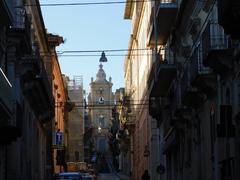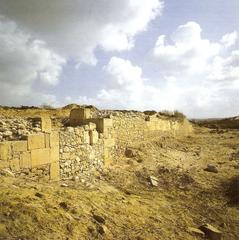Museo Benedettino Ragusa: Visiting Hours, Tickets, and Complete Guide
Date: 14/06/2025
Introduction
The Museo Benedettino in Ragusa, Sicily, is a unique destination for travelers seeking to immerse themselves in centuries of Benedictine spiritual, educational, and cultural heritage. Housed within the historically significant Monastery of San Giuseppe—renowned for its Sicilian Baroque architecture—the museum showcases the enduring influence of the Benedictine Order, their values of ora et labora (prayer and work), and their vital role in the city’s development. The museum’s evocative spaces, rich collections of sacred artifacts, and contemplative atmosphere offer visitors a window into both the past and the living traditions of Ragusa’s monastic community.
This detailed guide provides essential information about visiting hours, ticket options, accessibility, and practical tips for making the most of your visit. Whether your interests lie in art, architecture, spiritual history, or the daily life of Benedictine nuns, Museo Benedettino Ragusa is a must-visit during your exploration of Sicily.
For the latest schedules, ticketing details, and special event listings, refer to the Museo Benedettino website and the Monastero delle Benedettine del SS. Sacramento site.
Table of Contents
- Historical Evolution: Ragusa and the Benedictines
- The Monastery: Foundation and Baroque Splendor
- Museum Exhibits and Collections
- Visiting Hours, Tickets, and Accessibility
- Getting There and Nearby Attractions
- Special Events and Visitor Experiences
- Practical Visitor Tips
- Frequently Asked Questions (FAQ)
- Conclusion
- Sources
Historical Evolution: Ragusa and the Benedictines
Ragusa’s history stretches back to ancient times, shaped by Greek, Roman, and later Norman influences. A devastating earthquake in 1693 led to much of the city being rebuilt in the ornate Baroque style that defines Ragusa Ibla today (Tourist Secrets). The arrival of the Benedictines during the Middle Ages marked a turning point, as they established monasteries serving as centers of education, spiritual life, and social welfare.
The Benedictine Monastery of San Giuseppe, founded in 1611, became a beacon for female education and manuscript preservation—a rarity for the era. The nuns’ commitment to prayer, study, and community outreach helped shape Ragusa’s cultural landscape throughout the centuries.
The Monastery: Foundation and Baroque Splendor
The Museo Benedettino is housed within the Monastery of San Giuseppe, a masterpiece of post-1693 Sicilian Baroque. Its elliptical church plan symbolizes divine embrace, while the elegant cloisters, arcaded walkways, and intricate stucco illustrate the artistic patronage of the Benedictine community. The church interior features significant artworks, including a 17th-century statue of Saint Benedict and an 18th-century wooden statue of Saint Joseph adorned with Neapolitan silver.
Originally, the cloistered nuns attended liturgical services from behind “gelosie”—special grilles—preserving both their contemplative life and their participation in community worship (The World of Sicily).
Museum Exhibits and Collections
The museum’s exhibitions are thoughtfully arranged in the historic deambulatorio—the corridor behind the church choir. Here, visitors explore:
- Liturgical Artifacts: Precious monstrances, vestments, and sacred vessels.
- Historical Manuscripts: Illuminated texts and archival records documenting the monastery’s founding and evolution.
- Devotional Objects: Rosaries, altar linens, and embroidery reflecting daily monastic routines.
- Photographs and Visual Media: Illustrating the monastery’s enduring influence on Ragusa.
- Period-Furnished Rooms: Offering insights into the nuns’ daily life and work.
Interpretive panels are available in Italian and English. The museum also highlights the ongoing presence of the Benedictine community, with opportunities to observe public liturgies and Eucharistic adoration.
Visiting Hours, Tickets, and Accessibility
Museo Benedettino Ibla (Obsculta)
- Location: Piazza Pola, Ragusa Ibla
- Opening Hours (April–October):
- Monday to Saturday: 10:00–13:00
- Monday, Wednesday, Friday: also 15:30–17:30
- Closed Sundays and during January, February, March, and December
(Comune di Ragusa)
- Admission: Free. No ticket required (Museionline). Donations are welcome.
- Accessibility: Wheelchair-friendly restrooms and ramps are available, though some historic areas may be less accessible. Contact the museum in advance for assistance.
- Guided Tours: Available upon request, often led by nuns or knowledgeable staff.
Museo Benedettino Ragusa Superiore
- Location: Ragusa Superiore, near Piazza San Giovanni
- Opening Hours:
- Tuesday to Sunday: 9:00–13:00 and 15:00–18:00
- Closed Mondays. Hours may vary seasonally.
- Admission: Usually €3–€5, with discounts for students, seniors, and children.
- Accessibility: Most public areas are accessible; some historic spaces may present challenges.
Getting There and Nearby Attractions
- By Foot: Both museum locations are accessible from main streets in Ragusa Ibla and Ragusa Superiore. Signage from central piazzas leads visitors through charming alleys.
- By Public Transit: Local buses and taxis run from Ragusa Superiore to Ibla and the main bus terminal.
- Parking: Public parking is available near Piazza Matteotti and on the outskirts of Ibla’s pedestrian zone.
Nearby Attractions:
- Duomo di San Giorgio: Baroque cathedral just steps away from the museum in Ibla.
- Giardino Ibleo: Panoramic public gardens perfect for a stroll.
- Museo Archeologico Ibleo: Archaeological museum in Ragusa Superiore.
- Local Cafés and Shops: Enjoy Sicilian pastries or browse artisan crafts in the vicinity.
Special Events and Visitor Experiences
The museum regularly hosts:
- Temporary Exhibitions: Focused on Sicilian monasticism, Baroque art, and local heritage.
- Workshops & Lectures: Covering Benedictine spirituality, manuscript preservation, and embroidery.
- Spiritual Retreats: Opportunities for meditation, prayer, and reflection.
- Cultural Festivals: Special programming during local events such as Estate Iblea.
For schedules and bookings, check the official website or contact the museum directly.
Practical Visitor Tips
- Dress Code: Modest attire is recommended—cover shoulders and knees to respect the setting.
- Photography: Permitted without flash, except during services or in restricted areas.
- Visit Duration: Plan 30–60 minutes for self-guided visits; longer if attending a guided tour or event.
- Facilities: Restrooms are available. Gift shops offer books and local crafts. Restaurants and cafés are nearby.
Frequently Asked Questions (FAQ)
Q: What are the Museo Benedettino visiting hours?
A: Hours vary by location and season. Ibla: Monday to Saturday, 10:00–13:00 (plus select afternoons). Superiore: Tuesday to Sunday, 9:00–13:00 and 15:00–18:00. Always check the official website for current schedules.
Q: Is there an entry fee?
A: Ibla: Admission is free. Superiore: €3–€5, with discounts available.
Q: Are guided tours available?
A: Yes, upon request—especially recommended for groups or during special exhibitions.
Q: Is the museum accessible?
A: Most public areas are accessible, but some historic sections may have steps or uneven floors. Contact staff for assistance.
Q: Can visitors participate in spiritual activities?
A: Yes, the museum is part of an active monastery; visitors may observe or join public liturgies and request prayers.
Conclusion
Museo Benedettino Ragusa bridges art, spirituality, and history in a serene Baroque setting. Its welcoming atmosphere, rich collections, and opportunities for reflection make it a highlight of any visit to Sicily. Whether exploring the tranquil cloisters, discovering rare manuscripts, or engaging with the living Benedictine tradition, you’ll gain a deeper appreciation for Ragusa’s unique heritage.
For up-to-date information, download the Audiala app, follow museum social media channels, and consult the official Comune di Ragusa museum page and Museionline listing.
Visuals and Media
Alt text suggestions for images:
- “Baroque facade of Museo Benedettino in Ragusa Ibla”
- “Interior of the deambulatorio with sacred objects”
- “17th-century statue of Saint Benedict inside the museum”
- “View through monastery gelosie into the church nave”
Sources
- Museo Benedettino Ragusa: Visiting Hours, Tickets & Historical Significance (Tourist Secrets)
- Museo Benedettino Ragusa: Visiting Hours, Tickets, and Cultural Insights (benedettine-rg.it)
- Museo Benedettino Obsculta Ragusa: Visiting Hours, Tickets, and Historical Insights (Comune di Ragusa)
- Museo Benedettino Ragusa: Visiting Hours, Tickets, and Guide to This Historic Site (Tourist Secrets)
- Museionline: Obsculta Museo Benedettino
- The World of Sicily: Museo Obsculta

